A group tour today, once again down in the Brecks. There was thick fog this morning on the drive down, although the sun was doing its best to burn it off already in places. The Met Office had promised it would clear this morning and they are always right, aren’t they? Well, thankfully for once they were!
We met at Lynford Arboretum. We might have gone first down to the river at Santon Downham, but it is always foggiest in the river valley and latest to burn off there, so we opted for a walk around the Arboretum instead. It was still pretty foggy here first thing, but at least there were signs of brightness appearing.
 A foggy arboretum – first thing this morning
A foggy arboretum – first thing this morning
As we walked into the arboretum, we could hear Nuthatches piping and Goldcrests singing. From the gate, the remains of yesterdays seed mix was still on the ground, though not much had escaped the attention of the hordes. Still, there were plenty of Great Tits, Blue Tits and Coal Tits picking around among the scraps. There were more tits on the huge cage of fat balls and several Long-tailed Tits were picking round there. Once again, there was no sign of any Hawfinches here today, and it looks like they will not be using this area to feed this year, for whatever reason.
With the fog still thick in the valley beyond, we had a walk around the top of the arboretum where the fog seemed to be slowly starting to clear. We could hear lots of Siskins calling and zooming around the tops of the trees. Eventually we caught sight of a male singing in the very top of a tall conifer. He dropped down into the fir to feed and when he reappeared on the front edge, he perched out in full view in the first rays of sunshine, his yellow underparts shining bright. Very smart.
We saw a couple of Mistle Thrushes fly through the trees calling, and as we walked back, one had started to sing. We stopped to listen to it for a second – a fluted phrase, a long pause as if deep in thought as to what to say next, and then another phrase a little different from the previous one. As we walked further round we flushed a couple of Song Thrushes from the grass which flew into cover in a low laurel hedge. As we approached, we could see them down on the ground in the vegetation. One of them then flew up and perched nicely for us in a bare tree. A Treecreeper appeared low down on one of the trees and we watched it singing as it climbed up the trunk – we could see its bill opening and closing in time to the song.
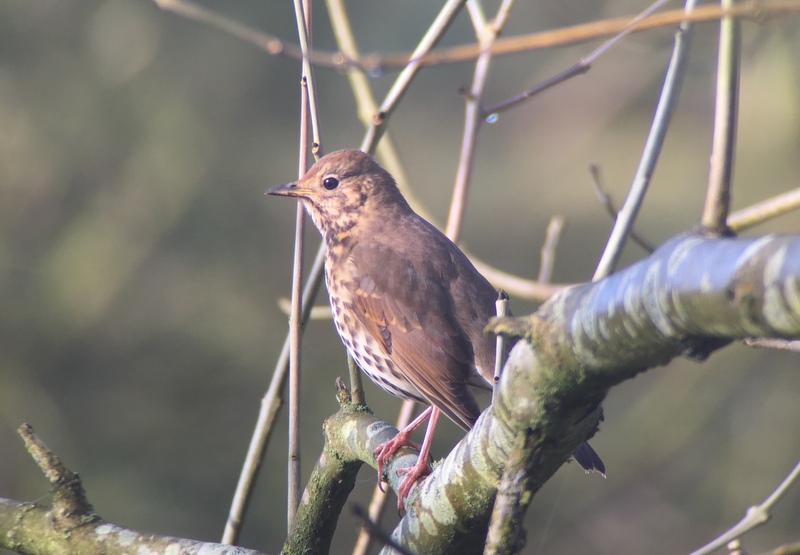 Song Thrush – perched up nicely for us
Song Thrush – perched up nicely for us
The fog was now starting to burn off nicely, even down to the lake, so we walked on down the hill. We could hear a Little Grebe calling, like maniacal laughter coming from the water. Round at the bridge, a pair of Reed Buntings were picking at the scraps left from yesterday’s food.
We decided to have a quick look at the paddocks. We were a bit later arriving here than ideally we would have been, due to the fog, but there was an outside chance we might still come across a Hawfinch flying in to feed with the sun now shining. There were lots of thrushes here – they are all feeding down in the grass in the paddocks at the moment. A Song Thrush was singing and a Redwing perched up nicely in the sunshine. As we stood scanning the trees, we could just hear a ticking Hawfinch, but it seemed to be coming from low down in the tangle of trees already and we just could not see, it in there. Then it went quiet. We waited a while in case it should reappear, but there was no sign.
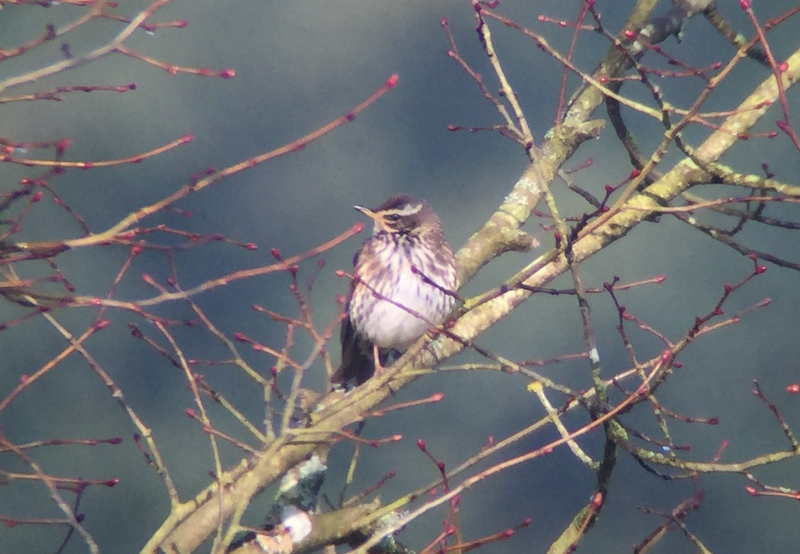 Redwing – enjoying the morning sun after the fog lifted
Redwing – enjoying the morning sun after the fog lifted
With the air warming up noticeably now the sun was shining, we wanted to make sure we got into forest in good time, so we headed back to the car. We knew we would have a better opportunity to see Hawfinches later. We drove deeper into the forest and walked out along a ride deep into the trees. A couple of Yellowhammers were singing against each other from a small clearing on the way, but we could not see either of them today on their favoured perches.
We eventually found ourselves at a larger clearing. There were Skylarks singing and fluttering round over the grass, but the Woodlarks were a little more subdued today. There was a definite chill in the light breeze blowing across the open ground, which perhaps was still keeping a lid on activity. We could hear a Woodlark calling softly as we walked across the clearing and a careful scan found a pair on the ground, picking around in and out of the vegetation. We had a look at them in the scope, although they were hard to follow as they made their way along the furrows. We assumed that the Woodlark activity levels would pick up as the temperature rose, but that was not to be the case while we were there today.
It was quiet at first in the sky over the clearing, too. A Sparrowhawk circled up distantly, over the trees, before dropping away from us quickly. It took a while for the Common Buzzards to get going today. Eventually we started to see a few of them taking to the air, and that was the cue for the Goshawk to show itself too. It circled up over the trees at the back, flashing very bright white below, especially around its undertail coverts, and alternately pale silvery grey as it turned in the sunshine.
 Goshawk – a recent photo of one over the cleaing
Goshawk – a recent photo of one over the cleaing
It could obviously see a thermal rising, because it circled across to the side of the clearing and started to gain height more rapidly, climbing way up into the sky. Then it turned and started a long glide high over the clearing to the other side, before circling up again and drifting away out of view. In all the that it was on view, we barely saw the Goshawk flap its wings, such effortless mastery of the skies. We waited a while, watching more Common Buzzards circling up, even displaying tentatively. A little later, the Goshawk appeared again just above the trees, a bit closer this time, and circled for a while before drifting away from us out of view.
There was still very little activity from the Woodlarks, but as we started to walk back round the clearing, a pair flew up from the ground in front of us. They circled round above us, giving us a great view of their short tails and broad wings, the male singing quietly. Then they dropped back down into the clearing. We watched where they landed and walked round to where we had the sun behind us. What was presumably the male was standing on the top of a small mound of earth, keeping watch. We had great views from here, noting as it turned its head from side to side the way the pale supercilia on the sides of the head met in a shallow ‘v’ on the back.
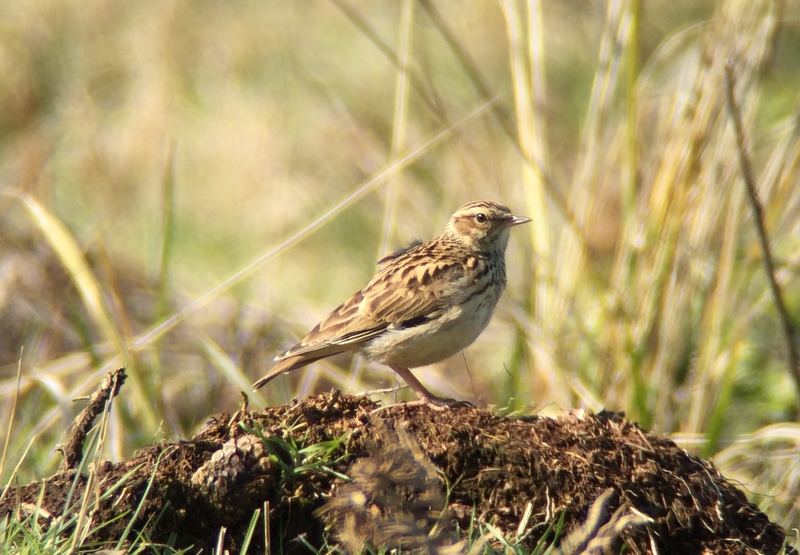 Woodlark – stood for some time on a small mound of earth
Woodlark – stood for some time on a small mound of earth
On our walk back to the car, a report came through that the Great Grey Shrike was again at Grimes Graves, where it seems to have settled in recent days. Just in case it might decide to leave later, we headed straight round there next. It was a little distant at first, and there was now a surprising amount of heat haze, but we could still see it clearly as soon as we arrived, a distinctive bright pale grey and white bird perched right on the top of a small tree. It kept flying down to the ground, before flying up to the top of a different tree.
It gradually worked its way a little closer to us, before disappearing over towards the fence on the edge of Grimes Graves, out of view behind the trees. We thought that might have been the best of it for today, until we noticed two photographers climbing into the Grimes Graves compound. As they walked along the grass, they suddenly realised the Great Grey Shrike was quite close to them, because we saw the cameras pointed in the direction of where we assumed the bird to be. The next thing we knew, it appeared from behind the trees, right in front of us.
 Great Grey Shrike – hunting around the clearing again
Great Grey Shrike – hunting around the clearing again
We stood quietly where we were and were treated to great views of the Great Grey Shrike flying around between the low hawthorn bushes and small trees in front of us. At one point it flew down and caught something, which it still had in its bill as it flew back to a bush, although we didn’t get a chance to see what it was – long and thin, too big and pale for an earthworm, perhaps a freshly emerged small reptile? It disappeared with it down into the base of another larger bush, and reappeared shortly afterwards without it. Perhaps it had stashed it in a larder for later. It was completely unconcerned with our presence amongst the trees and only when it eventually moved further away did we retreat and leave it to continue feeding in peace.
We drove round to Santon Downham for lunch, and afterwards walked up towards the churchyard. This is often a good spot for Firecrest, but they are slow to start singing in the spring (compared to the local Goldcrests). With the sun now shining it felt like a lovely spring day, so it seemed there was a chance there might be one singing today.
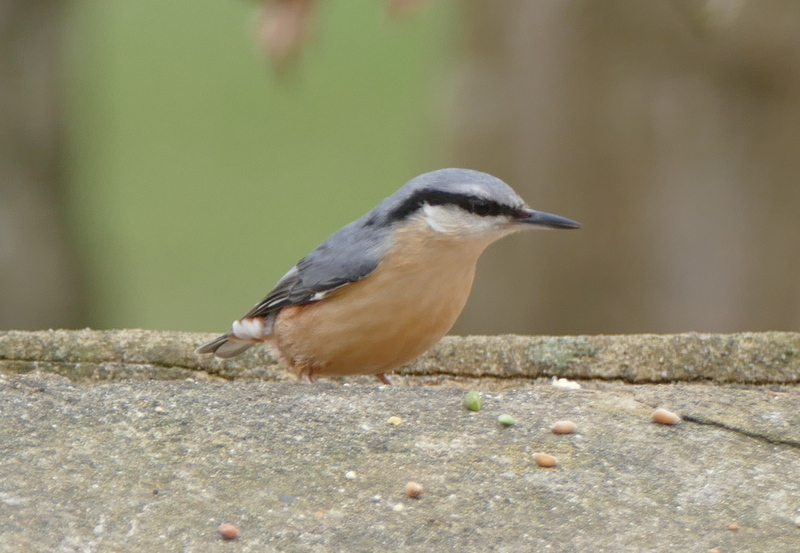 Nuthatch – ever present today, here’s one from yesterday
Nuthatch – ever present today, here’s one from yesterday
It was a little quiet at first, apart from a noisy pair of Nuthatches in the trees above our heads and a succession of cars up and down the road, but suddenly we heard a Firecrest singing quietly, high up in the fir trees behind us. We stared hard at the area where the song was coming from but couldn’t see anything moving there. Then a Goldcrest started singing as well from the same place – and that more obligingly flew out onto the sunny side of the trees in front of us and started flycatching around the branches.
The Firecrest sang again, from further over. It seemed to be moving unseen through the tops of the trees at the back of the churchyard. Several crests chased each other down through the trees, but they all appeared to be Goldcrests – presumably a couple of rival males were fighting, because one perched up in a bare deciduous tree with its crest fluffed out, the fiery orange feathers in the middle of its yellow crown stripe raised up and positively glowing in the sunshine.
Finally the Firecrest sang again and this time appeared in the front of an ivy-covered fir tree. It flicked around in and out of the foliage for a minute or two, flycatching a couple of times, and after one sortie it perched up beautifully in the clear where picked we could get a great look at it. Then it flew back across churchyard and disappeared into the trees again.
We walked down to the river to see if anything was along the banks, but there was a lot of disturbance here now, with plenty of people out enjoying the sunny afternoon. We could hear a Great Spotted Woodpecker calling, and one flew out of a tree and disappeared off ahead of us. We decided to head back round to Lynford, to have a proper go at seeing the Hawfinches instead.
There were no more seeds down on the ground by the feeders as we walked past, but a Marsh Tit had joined the other tits in trying to make the most of what food was left. It kept darting in and out, grabbing a beakful of food before disappearing back into the trees to deal with it. A Nuthatch was doing the same and a Great Spotted Woodpecker appeared briefly in the trees above. Down at the bridge, the food had similarly not been replenished today, though one of the group tried to supplement what crumbs were left with a few handfuls of nuts from his pocket!
There was a small crowd gathered on the path the other side of the lake, looking into the sun towards the nearest trees. They had seen a Hawfinch drop down on the ground but it was only giving occasional glimpses of a bill or part of a head in amongst all the vegetation. There were several Chaffinches feeding in there too, and a selection of thrushes in the wet field in front. We had a quick look but could hear the Little Grebe cackling out on the water, so went along for a look at that instead. It was looking very smart now, but quickly disappeared back into the reeds to feed.
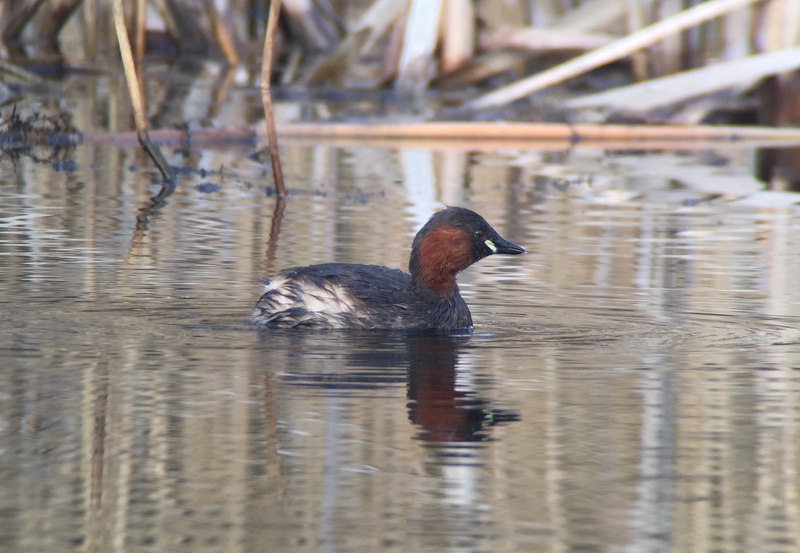 Little Grebe – in the same place as yesterday, as seen here
Little Grebe – in the same place as yesterday, as seen here
When we came back to the small crowd, the Hawfinch was still down on the ground, but it was getting time for the birds to finish feeding. It flew up, first into a hawthorn, then into the taller hornbeam beyond, but it was hard to see in amongst all the branches and into the sun. We walked round to other side of the paddocks where we were not looking into the light, though it was still partly obscured. As it hopped around through the tree and by constantly adjusting the position of the scope, we gradually got some better views. We could see the huge nutcracker of a bill.
Eventually the Hawfinch flew across to the next hornbeam, so we walked along a little further. It was very hard to see in here at first, though we could hear it calling all the time now. It hopped down through the tree, then up again, mostly partly obscured from view still. When it got up towards the top, we managed a much better view when it hopped out next to a Mistle Thrush. This time we could see that it was a female, noting the big head and black bib and mask. The resident female Kestrel was also still flying around between the wires which cross the paddocks and we had a nice close look at her too.
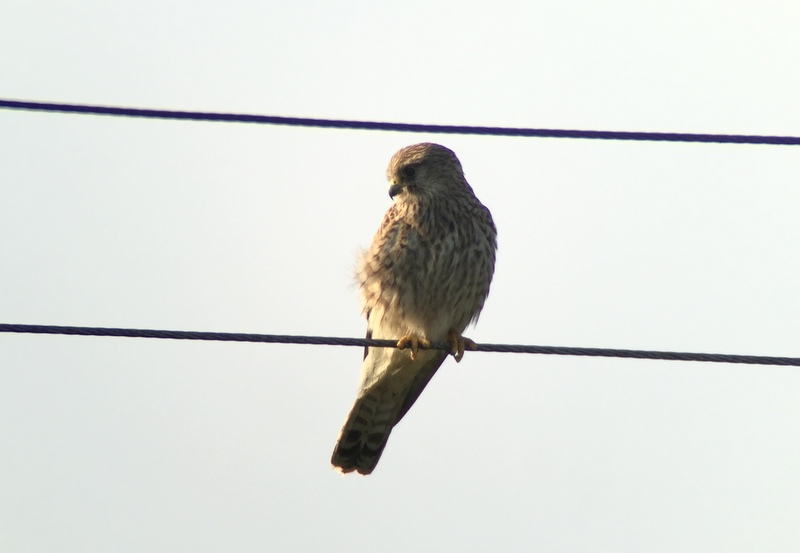 Kestrel – around the wires across the paddocks as usual
Kestrel – around the wires across the paddocks as usual
At this point we spotted another Hawfinch distantly in the top of the trees beyond, silhouetted against the sky. When the first Hawfinch flew over to the back of the next group of trees, out of view, we decided to walk up to the end of the paddocks to see if we could see this second bird. There was no sign of it when we got there, but looking back across the paddocks we could see the first female right in the top of one of the trees. From this direction, with the light behind us, we could get a really good unobscured view of it for the first time. We could also see it was still calling – its bill was moving.
 Hawfinch – finally giving better if distant views
Hawfinch – finally giving better if distant views
Our perseverance was paying off and we were gradually getting better and better views of the Hawfinch. Then it flew across to the tops of the pines in front of us and it was better still. We could see the very short, white-tipped tail, and the combination of greys and browns in the body colours. We watched it for a while, flitting around between the tops of the pines, enjoying the late afternoon sun. But it was always on its own and there was no sign of the second Hawfinch we had seen earlier of any other birds.
 Hawfinch – finally rewarded with great views in the afternoon sun
Hawfinch – finally rewarded with great views in the afternoon sun
Then suddenly the Hawfinch flew up and headed off strongly south. We watched it as it flew – the distinctive, bounding flight action, the heavy head and short tail, the bold white wing-stripe. The as it disappeared over the trees beyond, we decided it was time for us to call it a day too. It was a great way to end.
















